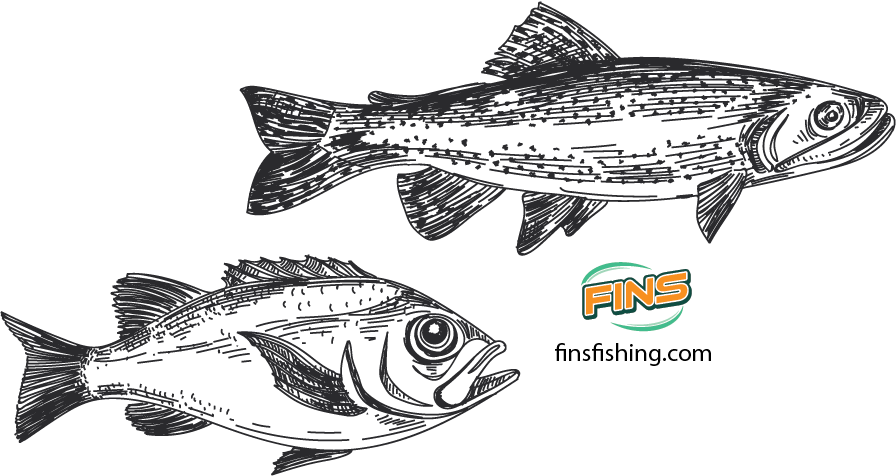Recreation for some and sport for others, fishing is more popular than ever among Americans. With over 44 million identifying as recreational anglers, fishing is now the second-most popular outdoor activity in the United States.
There are different reasons for this growth, but a big one is technology. Through decades of experience and research, leading-edge companies such as FINS have used braid science to develop fishing lines designed to catch certain types of fish. And as the quality, performance, and purpose of fishing lines improve, angling has become accessible enough that even first-timers can easily pick it up and be successful.
Today, we're focusing on redfish, trout, and snook fishing. As with any species, multiple factors are involved, and knowing how to choose the best fishing line is vital to optimizing your chances of catching these opportunistic predators.
Fishing Lines Make a Difference
Experienced anglers know that preparation is the key to success. It's important to be familiar with the fish you want to catch, where you plan to catch them, and the right line for the occasion.
There are three main types of fishing lines — monofilament, fluorocarbon, and braid — and knowing the appropriate one to use in different situations is critical to how many fish land in your livewells.
Different things factor into what type of line you should use, and anglers will have to consider all of them:
Type of fish
What type of fish you're targeting, their size, strength, and behavior all matter. For example, bigger and stronger fish require lines with higher strength and abrasion resistance.
Water clarity and color
The visibility of your line depends on the color and clarity of the water, making this a significant factor to consider. In very clear water, fluorocarbon lines are popular. Modern braided lines also come in various colors to accommodate the different shades and structures of the water.
Preferred technique
Depending on what technique you prefer, such as casting, trolling, or bottom fishing, you'll want to opt for a matching type of finishing line. For example, braided lines are most popular for their casting distance and sensitivity, making them ideal for long casts or detecting subtle bites.
Type of lure and bait
Your choice of fishing line will also depend on what kind of lure or bait you plan to use. For instance, a floating monofilament line makes sense if you're after topwater fish. But anglers usually prefer braided lines that allow artificial baits to look more attractive in deeper water.
Stretch and sensitivity
How much a fishing line stretches directly affects how sensitive it feels to anglers. Monofilament lines have more stretch, making it easier for first-timers to handle, even if you lose sensitivity. Braided lines have minimal stretch and offer high sensitivity, making detecting subtle tugs and nibbles easier.
Wind-knot prevention
Some lines can form wind knots during longer casts depending on weight and diameter. Heavier lines frequently have this problem as they create more wind resistance, while smaller, lighter options easily cut through the air.
Abrasion resistance
Where you fish and the surrounding underwater structures can have all sorts of obstacles such as rocks, weeds, and debris that make it more likely for lines to break. Braided fishing lines usually offer the best resistance to abrasion, and companies such as FINS have demonstrated the superiority of their braided lines through abrasion resistance tests.
Budget
Although we're including it last, budget is often one of the most critical factors. Microfilament lines are cheaper but less durable, and you'll need to replace them more frequently. Braided lines are pricier, but they offer advantages that microfilaments don't, making it easier to be successful when redfish, trout, and snook fishing.
Redfish fishing
Redfish are a popular game fish in the Atlantic and Gulf of Mexico. Their age and habitat affect how big they become. Usually, they measure between 20 and 30 inches and weigh between 6 and 12 pounds. However, mature redfish, known as "bull reds," can grow as long as 1 meter long and as heavy as 50 pounds.
Redfish are opportunistic bottom-feeding predators that eat crabs, shrimp, and other small fish. They have a strong sense of smell and are less line-shy than others, so you'll be more likely to get a bite. However, redfish are notoriously strong and aggressive and are guaranteed to put up a fight when hooked, creating an extra element of challenge and excitement for anglers.
What's the best line for redfish fishing?
Finding the best redfish fishing line depends on how big they are and where you plan to catch them. For example, oyster beds and underwater structures are familiar places for redfish to sit in prey, so choosing a line that's less prone to abrasion makes sense. Also, since redfish are known for never giving up without a fight, a sensitive braided line with a high weight resistance is ideal.
The question of what braid is best for redfish will still depend on the average size you expect to catch. FINS' collection of WindTamer braids has you covered. Braids start at 10 pounds of resistance and reach 200, meaning no redfish can out-battle the WindTamer. As the name suggests, the thin, lightweight braids cut through the wind as you cast your line, helping you avoid wind knots.
Trout fishing
Trout fishing is one of the most popular among anglers as this freshwater fish species has many habitats, including in North America, Europe, and Asia. Trout are medium-sized, averaging 10 to 20 inches long and 1 to 5 pounds. However, some larger species, such as brown trout, can grow up to 30 inches and weigh 20 pounds.
Trout are beautiful and tasty but also strong and agile with excellent eyesight. This combination of features poses a sporting challenge that most anglers can't resist.
What's the best line for trout fishing?
The best trout fishing line is usually a fluorocarbon lead and braided main line. Because trouts have such good eyesight, using only a braided line might easily spook them, though green braids have proven effective in many trout habitats. To get around the issue, combining a more transparent lead with a light braided main line has the best effect.
Regarding what braid is best for trout fishing, we recommend the FINS Spin5. Made from a unique 5-end braid structure that's 35% rounder than traditional 4-end braids, the Spin5 is also thinner in diameter versus the 4-end, making it ideal for catching trout.
Snook fishing
Snook are found in fresh and salt waters and are sneaky predators that ambush and feed on smaller fish at opportunistic moments. They are medium- to large-sized fish, around 18 inches long, and weigh 30 pounds. However, the largest member of the snook family, the common snook, can be much bigger and grow to be as heavy as 60 pounds. Snook are aggressive eaters who usually take the bait if it's presented right. Artificial bait tends to be more effective as snook are excitable and more likely to respond to something flashy. When on the hunt, snook usually hide in sea grass, mangroves, or other structures, and they like being sneaky about it.
What's the best line for snook fishing?
The best snook fishing line factors in their size, behavior, and environment. Catching snook requires fishing lines that can handle more weight and resistance. Also, since snook are likely to hide among obstacles and structures, abrasion-resistant lines are best. Considering this, a fluorocarbon lead — to account for snook's skittishness — with a braided fishing line to handle their weight and strength is the best combination.
In terms of what braid is best for snook fishing, the FINS WindTamer Pitch Black offers the best of all worlds. With strength tests going as high as 80 pounds, this unique variation of the versatile WindTamer series offers exceptional performance that makes it ideal for hooking and landing snook. Anglers can also say goodbye to the markers they carry in their tackles since Pitch Black Braid is made with superior fibers guaranteed to never bleed or lose color.
FINS: The Highest-Performing Braided Fishing Lines
We've entered a new era of fishing. After 25 years of manufacturing some of the world's top fishing lines, BBS Tech developed FINS, its own brand of high-performance fishing braid.
As the last remaining manufacturer of premium fishing braids owned and operated in the United States, FINS offers an extensive selection of high-performance braids suitable for every angling occasion. Using the newest technology and proprietary manufacturing techniques derived from braid science, FINS has revolutionized the market so that braided fishing lines may soon become the industry standard.
Ready to take it to the next level? Spool your FINS line onto a Blackfin Rod and see how FINS has changed the game for braided fishing lines.




